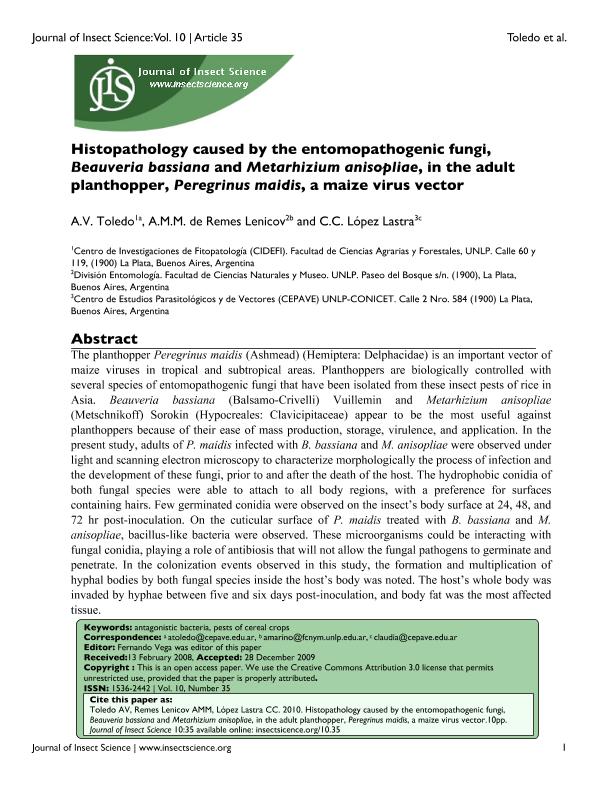Mostrar el registro sencillo del ítem
dc.contributor.author
Toledo, Andrea Vanesa

dc.contributor.author
de Remes Lenicov, A.M.M.
dc.contributor.author
Lopez Lastra, Claudia Cristina

dc.date.available
2021-02-12T03:26:10Z
dc.date.issued
2010-04
dc.identifier.citation
Toledo, Andrea Vanesa; de Remes Lenicov, A.M.M.; Lopez Lastra, Claudia Cristina; Histopathology caused by the entomopathogenic fungi, Beauveria bassiana and Metarhizium anisopliae, in the adult planthopper, Peregrinus maidis, a maize virus vector; University of Arizona; Journal of Insect Science; 10; 1; 4-2010; 1-10
dc.identifier.issn
1536-2442
dc.identifier.uri
http://hdl.handle.net/11336/125554
dc.description.abstract
The planthopper Peregrinus maidis (Ashmead) (Hemiptera: Delphacidae) is an important vector of maize viruses in tropical and subtropical areas. Planthoppers are biologically controlled with several species of entomopathogenic fungi that have been isolated from these insect pests of rice in Asia. Beauveria bassiana (Balsamo-Crivelli) Vuillemin and Metarhizium anisopliae (Metschnikoff) Sorokin (Hypocreales: Clavicipitaceae) appear to be the most useful against planthoppers because of their ease of mass production, storage, virulence, and application. In the present study, adults of P. maidis infected with B. bassiana and M. anisopliae were observed under light and scanning electron microscopy to characterize morphologically the process of infection and the development of these fungi, prior to and after the death of the host. The hydrophobic conidia of both fungal species were able to attach to all body regions, with a preference for surfaces containing hairs. Few germinated conidia were observed on the insect's body surface at 24, 48, and 72 hr post-inoculation. On the cuticular surface of P. maidis treated with B. bassiana and M. anisopliae, bacillus-like bacteria were observed. These microorganisms could be interacting with fungal conidia, playing a role of antibiosis that will not allow the fungal pathogens to germinate and penetrate. In the colonization events observed in this study, the formation and multiplication of hyphal bodies by both fungal species inside the host's body was noted. The host's whole body was invaded by hyphae between five and six days post-inoculation, and body fat was the most affected tissue.
dc.format
application/pdf
dc.language.iso
eng
dc.publisher
University of Arizona

dc.rights
info:eu-repo/semantics/openAccess
dc.rights.uri
https://creativecommons.org/licenses/by-nc-sa/2.5/ar/
dc.subject
ANTAGONISTIC BACTERIA
dc.subject
PESTS OF CEREAL CROPS
dc.subject.classification
Micología

dc.subject.classification
Ciencias Biológicas

dc.subject.classification
CIENCIAS NATURALES Y EXACTAS

dc.title
Histopathology caused by the entomopathogenic fungi, Beauveria bassiana and Metarhizium anisopliae, in the adult planthopper, Peregrinus maidis, a maize virus vector
dc.type
info:eu-repo/semantics/article
dc.type
info:ar-repo/semantics/artículo
dc.type
info:eu-repo/semantics/publishedVersion
dc.date.updated
2020-12-04T18:43:48Z
dc.journal.volume
10
dc.journal.number
1
dc.journal.pagination
1-10
dc.journal.pais
Estados Unidos

dc.description.fil
Fil: Toledo, Andrea Vanesa. Universidad Nacional de La Plata. Facultad de Ciencias Agrarias y Forestales. Departamento de Ciencias Biológicas. Centro de Investigaciones de Fitopatología. Provincia de Buenos Aires. Gobernación. Comisión de Investigaciones Científicas. Centro de Investigaciones de Fitopatología; Argentina
dc.description.fil
Fil: de Remes Lenicov, A.M.M.. Universidad Nacional de La Plata. Facultad de Ciencias Naturales y Museo. División Entomología; Argentina
dc.description.fil
Fil: Lopez Lastra, Claudia Cristina. Consejo Nacional de Investigaciones Científicas y Técnicas. Centro Científico Tecnológico Conicet - La Plata. Centro de Estudios Parasitológicos y de Vectores. Universidad Nacional de La Plata. Facultad de Ciencias Naturales y Museo. Centro de Estudios Parasitológicos y de Vectores; Argentina
dc.journal.title
Journal of Insect Science

dc.relation.alternativeid
info:eu-repo/semantics/altIdentifier/doi/http://dx.doi.org/10.1673/031.010.3501
dc.relation.alternativeid
info:eu-repo/semantics/altIdentifier/url/https://academic.oup.com/jinsectscience/article/10/1/35/831842
Archivos asociados
